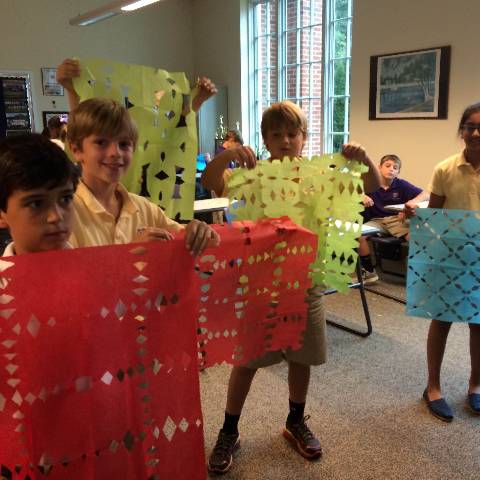To celebrate Hispanic Heritage Month, which takes place from September 15 to October 15, the third- through fifth-grade teachers and the enrichment teachers teamed up for an interdisciplinary project that integrated different parts of our curriculums.
In math, students learned about creating a symmetrical design and demonstrated their knowledge by creating their own papel picado. Papel picado is a Mexican art form of intricately cut paper designs and is widely displayed during El Día de los Muertos and other holidays.
The language arts activity focused on the study of folktales with an emphasis on Hispanic stories that have been passed down through several generations. Students learned the different types and elements of folktales.They were able to compare and contrast folktales, fairy tales, fables, legends, and myths. Common elements of a folktale are the rules of three such as three characters and three tests ("The Three Little Pigs") and the use of magic.
After reading common folktales, from Spanish-speaking countries, students were asked to create their own. Our third- through fifth-grade students are extremely creative! They developed interesting, modern day folktales that are relevant to their lives.
In Art, they drew Calaveras, again focusing on symmetry in the design. Calaveras, Spanish for skulls, are an important part of the Hispanic holiday El Día de los Muertos and can be found all over Mexico in a variety of forms and colorful designs. It is amazing to see how creative and artistic our students are! You can see their work hanging around Thatcher Hall.
In Spanish, we discussed the evolution of languages and how they change over time. We focused in particular on the influence that Spanish and English have on each other in the United States. As the Hispanic population continues to grow, Spanish and English are blending into a form of Spanglish. For instance, the Spanish word for lunch is almuerzo, but many Spanish speakers now use the word lonche, derived from the English word. In addition, we looked at cognates in English and Spanish and traced them back to their Latin roots.
Finally, in music they looked at the Conga line, Rumba, Samba, Salsa, Cha Cha, Tango, and Merengue. Students learned the basic Cha Cha steps and formed their own conga line!
This special day was a great way for the teachers to cooperate and combine their areas of learning while giving the students a deeper understanding of the Hispanic people through a variety of fun activities. We can’t wait to partner up again soon!

